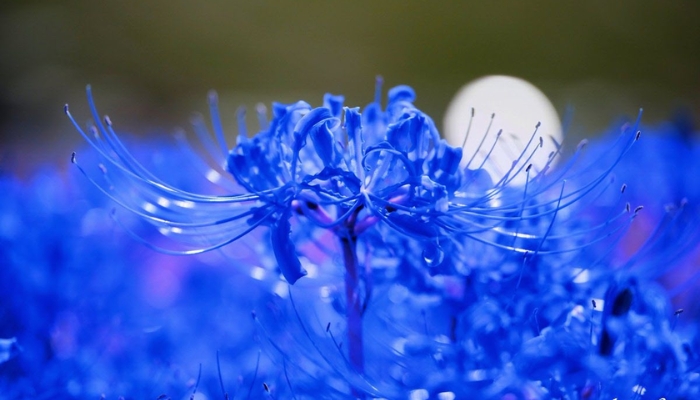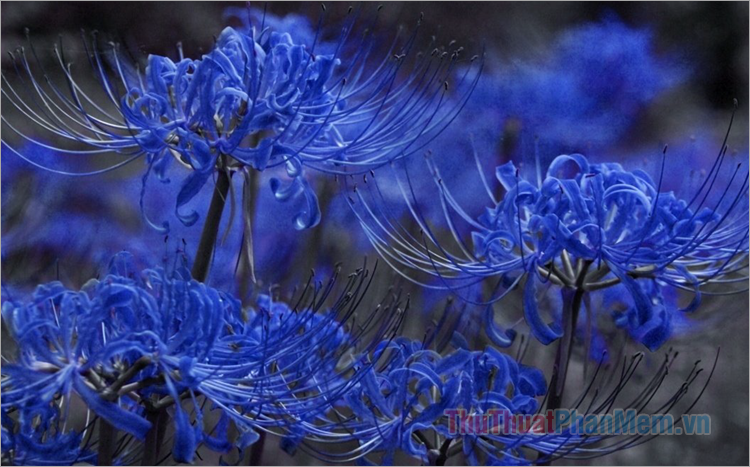
When it comes to flowers symbolizing sadness, parting, and mourning, many people immediately think of blue spider lilies. However, few are aware that hidden behind their negative connotations lies a profound belief and immense hope. Blue spider lilies come in various colors, and in this article, Hoa Của Tui will provide you with some information about the legends and meanings of blue spider lilies!
What are Blue Spider Lilies? Blue spider lilies come in various colors Blue spider lilies come in various colors Blue spider lilies are not only scientifically known as Lycoris Radiata (or Spider Lily), but they also have different names such as Mạn Châu Sa Hoa, Hồng Hoa Thạch Toán, Long Trảo Hoa, and more. Originating from Japan and China, the presence of blue spider lilies in the poetry, songs, and films of these two countries is abundant.
However, each country has its own interpretation of the meaning of blue spider lilies. In China, they symbolize separation and farewell. In Japan, they represent painful memories. In Korea, they signify poignant longing for loved ones.

Blue spider lilies come in five main colors: red, pink, yellow, light purple, and white. So, how about blue spider lilies? Let’s find out below.
Are Blue Spider Lilies Real? Blue spider lilies are not real Blue spider lilies are not real Blue spider lilies carry a rather unique color among the various species of spider lilies. After the anime series “Kimetsu no Yaiba” (Demon Slayer) from Japan, this flower became extremely popular and drew the attention of many. As mentioned in the anime, the distinct color of blue spider lilies also comes with unique effects, such as making the character Muzan immortal.
In the original “Kimetsu no Yaiba” work, blue spider lilies only bloom during the day, and the time from blooming to withering is very short. In some places with unfavorable climates, these flowers may not even bloom.
So, are blue spider lilies real? The answer is No. In reality, these flowers do not exist; they are only part of the legend. In the real world, spider lilies come in only five colors. Red spider lilies, in particular, are popular and inseparable from the cultural life of East Asian people, including Vietnam.
The Legend of Kimetsu The legend of blue spider lilies is mentioned in the Japanese manga “Kimetsu no Yaiba” (Demon Slayer). In this story, the character associated with the flower is Muzan. According to the plot, this flower can help him cure a dangerous illness. Specifically:
Among the medicines created by doctors to treat Muzan’s severe illness, blue spider lilies are one of the essential components. However, Muzan caused his doctor to lose his life permanently before he could finish the medicine due to his increasing disappointment with his deteriorating condition.
Later, Muzan realizes that the medicine is actually effective. Although he obtains a powerful body, because the medicine is a prototype, he becomes sinister, unable to step into the light, and turns into a person embracing darkness.
When Muzan realizes the effective treatment method, he deeply regrets harming his doctor. Since he doesn’t know how to end the treatment process and create the medicine without blue spider lilies, he has been tirelessly searching for this flower for many centuries, hoping to complete the treatment and create a perfect immortal body.
The Departure of Muzan occurs about 100 years later. Aoba Hashibira, a botanist, tries to study blue spider lilies and discovers that these flowers only bloom during the day. They also have a very short blooming time before quickly wilting. In some cases, they may not even bloom due to unsuitable climates.
Aoba Hashibira’s research explains why Muzan never found blue spider lilies. Since he couldn’t go outside during the day, he would never encounter the blooming blue spider lilies.
Understanding the Meanings Although blue spider lilies do not exist and only exist in legends, in those legends, they are associated with a “dark character.” Therefore, the meaning of blue spider lilies represents separation, mourning, pain, and guiding the lost in their next life. However, besides being a symbol of sorrow and separation, this flower also brings incredibly strong faith and hope in life.
The interpretation of blue spider lilies depends on the perspective of each country and individual. But in general, spider lilies often symbolize memorable and sorrowful memories in love for each person.
What is the Meaning of Blue Spider Lilies in Feng Shui? It can be seen that blue spider lilies, which originally only existed in legends, are still used as symbols for display, souvenirs, or photographs. So, what is the meaning of blue spider lilies in Feng Shui? If you have this question, let’s explore the following information to find the answer.
Blue Spider Lilies have Feng Shui meaning Blue Spider Lilies have Feng Shui meaning At first glance, the dark and gloomy deep blue color of blue spider lilies may easily give the impression of bad luck. This is true, but not enough. Beyond the negative meaning of blue spider lilies, they also symbolize many other things. The deep blue color can represent abundant faith and hope. The petals of blue spider lilies bring strength and intensity to emotions.
In Feng Shui, blue is associated with calmness, tranquility, and spiritual growth. Therefore, blue spider lilies can be used as a Feng Shui symbol to bring a sense of serenity and peace to a space. They can also be used to enhance spiritual practices and promote a deeper connection with oneself.
However, it’s important to note that blue spider lilies, being a fictional flower, do not have traditional Feng Shui meanings like other natural flowers. Their symbolism in Feng Shui is more based on personal interpretation and the intentions behind their use.

In conclusion, blue spider lilies, although not real, hold a significant place in legends and popular culture. Their meanings vary across different countries and interpretations. Whether it’s the symbolism of sorrow and separation or the representation of faith and hope, blue spider lilies continue to captivate our imagination and inspire contemplation.
